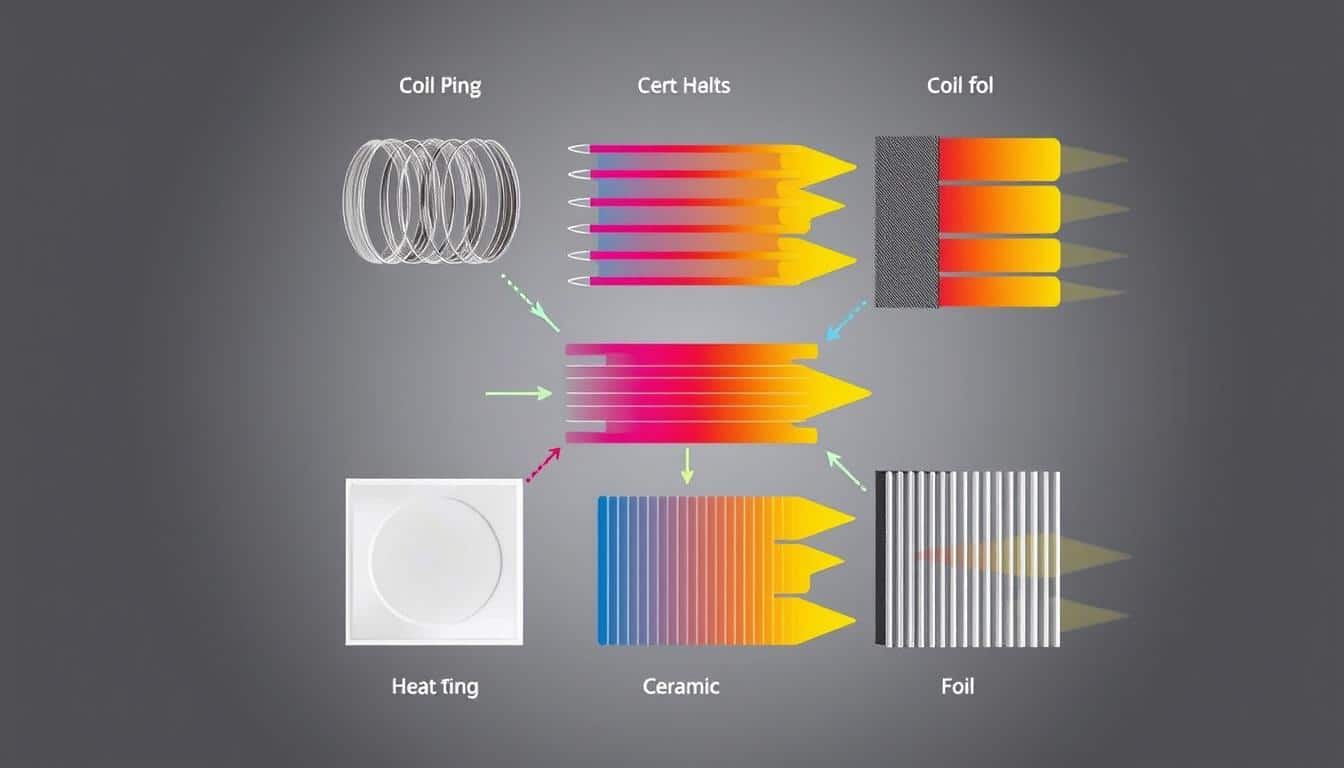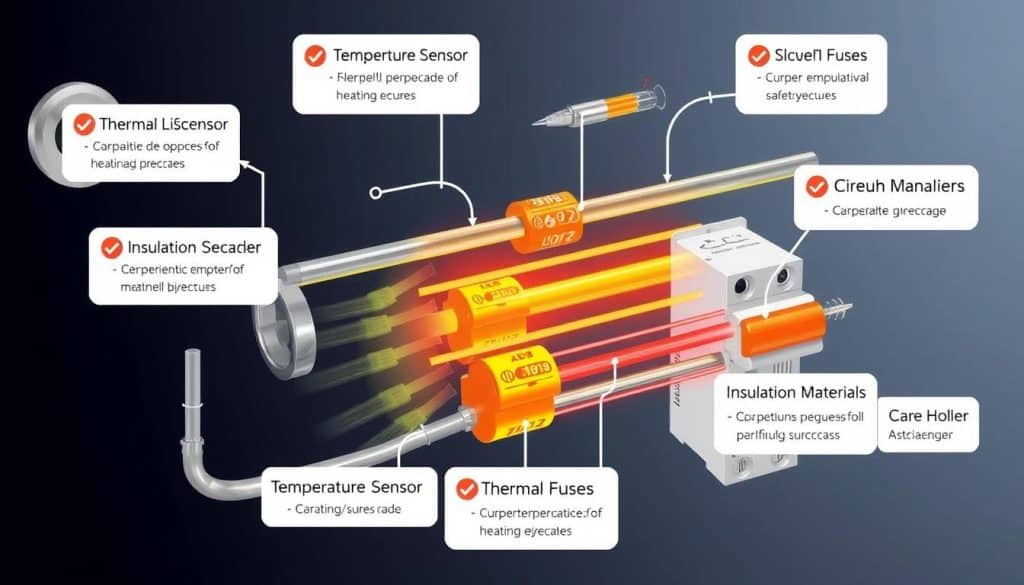How Does a Heating Element Function? | Quick Guide
Did you know a lot of vehicle recalls each year are because of heated seat issues? This shows the need for good heating elements. For example, Mazda had to recall some 2010 CX-9 models. They were recalled because the seat heater control circuits could overheat. This could cause burns or even fires, mostly in cold weather1. This fact underlines why it’s so important to understand how heating elements work. This knowledge is key for both safety and efficiency in our daily devices and cars.
Heating elements are crucial in appliances like electric stoves, heaters, and toasters. They turn electrical energy into heat using electrical resistance. This process is very important for controlling temperature. It lets you set how warm you want your meal or room. Knowing about heating elements helps you choose devices that are safe and save energy.
Key Takeaways
- Heating elements convert electrical energy into heat through electrical resistance.
- They are critical for temperature control in appliances like stoves and heaters.
- Understanding heating components enhances energy efficiency.
- Safety mechanisms prevent overheating and potential hazards.
- Vehicle recalls emphasize the importance of functional heating elements.
Introduction to Heating Elements
Heating elements heat up our appliances, like ovens and heaters, using electrical resistance. Over time, they have changed a lot. Now, we use newer technologies that work better and use less energy.
In the past, heating elements were basic metal coils. Now, they use materials like ceramic for longer life. This shows how much heating technology has improved, focusing on better heat and safety.
Heating elements are everywhere in our daily lives. They’re in things like ovens, water heaters, and big machines. Understanding them helps us use energy smarter and make better choices about the appliances we use.
Learning about electrical resistance helps us understand how heating elements work. There’s always new tech in heating elements. Keeping up with these changes helps us use energy more efficiently and be kinder to the environment.
A detailed understanding of heating elements enhances awareness of their importance in both residential and industrial applications.
Heating elements do more than just warm things up; they also affect how much energy we use. They’re key to making systems run better, showing their value in electrical engineering1.
Understanding Heating Components
Heating components are essential in many areas, from home appliances to industrial tasks. They work by turning electrical energy into heat using electrical resistance. Knowing about them helps you pick the best one for your needs.
Types of Heating Elements
Different heating elements exist, each turning electricity into warmth. Here’s a look at some common types:
- Resistive Wire: Found in toasters and space heaters. It’s a metal alloy that heats up with electricity.
- Ceramic Heating Elements: These are in hair dryers and heaters. Ceramic materials offer efficient, quick warmth.
- Quartz Heating Elements: Used for their fast heating. You’ll find them in infrared heaters and kitchen devices.
These heating parts show their worth in tested conditions. For example, in certain uses, Nb-doped elements show high efficiency2. Their makeup provides a strong structure for effective heating2.
Energy standards help improve heating part efficiency. Since 2007, Chile has worked on better housing insulation. This impacts how well heating works3. Such steps prove the importance of standards in heating performance.
| Type of Heating Element | Applications | Advantages |
|---|---|---|
| Resistive Wire | Toasters, Space Heaters | Cost-effective, reliable |
| Ceramic Heating | Hair Dryers, Ceramic Heaters | Quick heating, energy efficient |
| Quartz Heating | Infrared Heaters, Cooking Appliances | Rapid heating, easy installation |
Different heating elements have unique uses and benefits. Understanding them helps you use them better in various settings23.
How Does a Heating Element Function?
Let’s break down how a heating element works. It all starts with electrical resistance. This key idea shows us how electrical power turns into heat in the element. Ohm’s Law plays a huge role here, linking voltage, current, and resistance.
When electricity moves through the element, its resistance heats it up. This generates the heat we need for different uses.
The Principle of Electrical Resistance
Looking into heating elements, electrical resistance is crucial. It helps control the temperature. The type of material and its resistance level affect how well it changes electricity into heat. This also impacts the efficiency and performance of the heating element.
Heating elements can adjust their heat output. This is done through settings or automated systems. These systems keep the element working at the right level. They avoid overheating and make it safer for users. Knowing how heating elements operate, with a focus on electrical resistance, is key4. This helps us get the most from our heating tools.
Thermostat Operation
Thermostats are key to making sure your heater works right. They keep an eye on temperatures so everything stays comfortable and safe. This stops the heater from getting too hot. Good thermostat operation also means your energy bills could be lower.
The Role of Thermostats in Heating Elements
Thermostats make sure heating elements turn on just when needed. They check the room’s temperature and adjust the heat output. Rixen’s Enterprises offers different heaters, like instant water heaters and airtronics, showing how vital these controls are5. Their products can heat up spaces from 7,500 to 18,800 BTU, providing comfort and saving energy5.
This smart control leads to less energy waste and steady warmth. For instance, Rixen’s hydronic systems give you cozy zone heating, run quietly, and give you continuous hot water5. This shows thermostats play a big part in improving how heating systems work.
Energy Efficiency
Nowadays, focusing on Energy Efficiency in heating is more important than ever. Efficient heating parts help cut down on how much energy we use and reduce bills. Thanks to new technology, we see better materials and smart designs for heating elements. These are key to bringing down costs and helping the planet.
The Importance of Efficient Heating Elements
Old-school heating parts used a lot of energy. This meant higher bills for people and more pressure on the environment. But now, modern heating elements are all about Energy Efficiency. They use cutting-edge materials and tech to work better. Examples include Aluminum 6061 and Stainless Steel in making these elements6.
Studies have shown a big change in how old and new heating designs work. Old ones lost a lot of energy, but new models are much more efficient and use less energy. Going for Energy Efficiency in heating doesn’t just save money. It also means playing a part in a sustainable future by needing less energy and lowering emissions. This change is crucial with the growing focus on sustainability and protecting our planet7.
| Heating Component Type | Energy Consumption (kWh/Year) | Efficiency Rating |
|---|---|---|
| Traditional Electric Heater | 3,500 | 65% |
| Modern Heat Pump | 1,200 | 95% |
| Hydronic Radiant Floor Heating | 1,000 | 90% |
Summing it up, adding Energy Efficiency to heating is not just good for performance. It also helps us meet global goals for a healthier planet. Choosing efficient heaters lowers your carbon footprint and builds a better world. To learn more about heating technologies and efficiency, consider this helpful article.
Safety Mechanisms
Let’s talk about how heating elements work and the key safety features they have. These features make the system safer and more user-friendly. They also stop it from getting too hot or breaking down. Thanks to these, heating elements can be used safely in many different situations.
Preventing Overheating and Malfunctions
Features like automatic shut-offs, fuse systems, and smart temperature controls are very important. They keep you safe while you use heating elements. For example, over 111,000 Jeep Grand Cherokee vehicles from 2003-2004 were recalled because of issues with the heating elements1. More than 53,000 Cadillac CTS sedans from 2014-2016 had to be recalled for similar reasons1.
The right thermostat setup is key to stopping overheating. Issues with where thermostats were placed led to the recall of luxury cars like the Bentley Arnage and Rolls-Royce Silver Seraph1. Also, some Volvo cars from 1996 to 1997 had seat heaters that could be unsafe, showing the importance of good temperature control1.
A detailed comparison of the effectiveness of various safety mechanisms is provided in the table below:
| Vehicle Model | Recall Year | Affected Units | Safety Concern |
|---|---|---|---|
| Jeep Grand Cherokee | 2006 | 111,000 | Heating Element |
| Cadillac CTS | 2016 | 53,000 | Heating Element |
| Bentley Arnage | 1999 | N/A | Thermostat Positioning |
| Volvo 800 Series | 1997 | N/A | Heated Seat Issues |
| BMW 5-Series | 2004 | 18,000 | Heated Seat Issues |
These facts show how crucial good safety features are for heating elements. By regularly checking and testing them, we can make sure they work well and safely every time. To learn more about how vital these safety steps are, especially for electric heating in cars, click here.
Troubleshooting Techniques
Knowing the common problems with heating elements is key to fixing them. You might find issues like not enough heat, elements burning out, or temperature being all over the place. Learning basic troubleshooting can save you time and cash. It might mean you won’t need to call in an expert.
Common Issues and Solutions
First, look at the heating element for any visible damage. You might see burn marks or breaks, which means you need a new one. Sometimes, the issue is with the electrical setup, not the part itself. Make sure the element is getting power by checking the connections.
- Insufficient heating: Check voltage levels and use the right wattage for your device.
- Burnt-out element: You’ll likely need to replace a failed element.
- Erratic temperature output: A bad thermostat could be the cause; testing or replacing it might fix the problem.
Using a multimeter to test if the heating element works is a smart step. If you still have trouble, look up guides on fixing heating systems for help.
| Issue | Possible Cause | Solution |
|---|---|---|
| Insufficient Heating | Low voltage or faulty connections | Ensure proper voltage and connection integrity |
| Burst Element | Wear and tear or electrical issues | Replace the element |
| Erratic Temperature | Malfunctioning thermostat | Test or replace thermostat |
Focus on these troubleshooting steps to fix problems fast. Learning how heating elements work helps with repair work. It also boosts your knowledge about keeping appliances running well. For more detailed fix-it guides, check out the provided link. Always be careful and seek expert advice when needed8.
Maintenance Tips
Keeping your heating elements well-maintained is key for them to last longer and work better. Taking good care of your system not only makes it more efficient but also lowers the chances of problems later on. Here are some important tips to remember.
Ensuring Longevity and Performance
- Regular Cleaning: Dust and bits can build up on heating parts, making them less efficient. Keeping these parts clean helps them work better.
- Inspect Connections: Bad or weak connections can cause poor heating or waste energy. Regular checks make sure everything is tight and right.
- Monitor for Wear: Look out for any signs that parts are wearing out. Catching issues early can avoid bigger problems and expensive fixes.
- Consider Professional Installation: A skilled technician can make sure your device is set up correctly and covered by warranty. This know-how boosts efficiency and prolongs your heating system’s life.
- Schedule Routine Maintenance: Getting your system checked by experts regularly helps find and fix issues early. This keeps your heating elements running smoothly.
If you want your system to perform at its best, hiring a pro for setup and upkeep is key. Doing this greatly increases how long your heating parts last, making energy use more efficient and cutting down on costs. Putting money into professional installation is a smart choice for the future.
Professional Installation
Having a pro install your heating elements is key. Doing it wrong can raise your bills and pose dangers. Experts make sure everything is set up right, so it works well and safely. They also know the details of heating element setup, helping to avoid common errors.
Professional installation means your appliances last longer. Technicians check your system and fit each part perfectly. This care stops future problems, like overheating or breakdowns.
Choose skilled pros for the job. Their know-how ensures your heating system is reliable. A good service has a great track record and helps pick the best heaters for you. Investing in expert help for installing your heating units keeps your space safe and efficient8.








